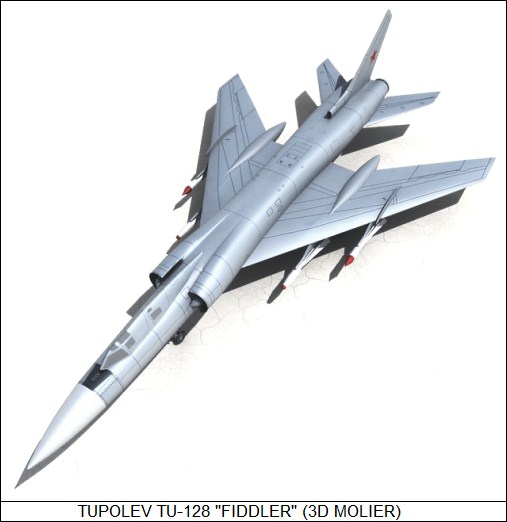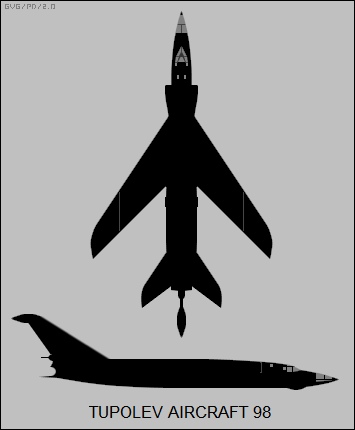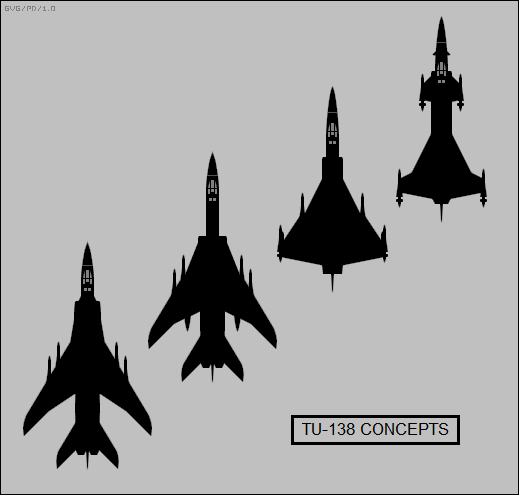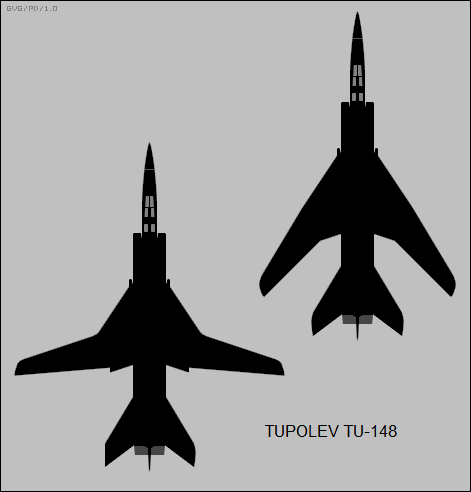
* During the height of the Cold War, the USSR invested substantial resources into the development of a formidable air-defense system to protect the Soviet nation. One of the more impressive elements of this system was the Tupolev "Tu-128", a big and powerful long-range interceptor that helped plug the gaps in the defensive barrier. This document provides a history and description of the Tu-128 -- as well as its predecessor, the experimental Tupolev "Aircraft 98" bomber.

* In the early 1950s, the Tupolev OKB conducted design studies on large supersonic jet aircraft, with one study begun in 1953 performed on a tactical bomber for the VVS -- "Voyenno Vozdushniye Sily", the Red Air Force -- with this design assigned the bureau designation of "Aircraft 98". The next year, the OKB was handed a directive by the authorities in Moscow to begin development of the Aircraft 98 bomber. It was to be powered by twin Lyulka AL-7F afterburning turbojets, and would have a top speed of at least 1,300 KPH (810 MPH / 700 KT).
As the design eventually emerged, it was a large aircraft made primarily of aircraft aluminum with a spindle-shaped fuselage, all swept flight surfaces, and the twin Lyulka engines arranged side-by-side in the rear fuselage. The fuselage featured the new "area ruling" concept, widening at the rear of the wings to ensure that the cross-sectional area changed as gradually as possible to ensure smooth airflow. The wings were mid-mounted, had a leading-edge sweep of 55 degrees, an anhedral droop of 5 degrees, and featured a full-width wing fence roughly at mid-span to prevent airflow from migrating down the span of the wing and robbing the wing of lift.
The tail surfaces were all swept, with a remote-control tail turret featuring twin AM-23 23-millimeter cannon in a bullet fairing near the base of the tailfin, and a PRS-1 Argon radar gunnery targeting system in a fairing at the top of the tailfin; there was also an Initsiativa bombing-navigation radar in a fairing under the nose. Apparently thought was given to putting a fixed AM-23 cannon in the nose, but it doesn't seem to have ever been fitted. There was an internal bomb bay, capable of accommodating a nuclear store or four FAB-1000 1-tonne (1.1-ton) general-purpose conventional bombs.
Each AL-7F engine provided 63.8 kN (6,500 kgp / 14,330 lbf) dry thrust and 93.2 kN (9,500 kgp / 20,950 lbf) afterburning thrust. The intakes were placed high on the fuselage, behind the cockpit, and had an oval configuration. The aircraft featured tricycle landing gear, with twin-wheel steerable nose gear retracting backward and four-wheel main gear, arranged as 2x2 bogies, also retracting backward into the fuselage, the bogies flipping over as they were tucked away. The landing gear arrangement gave the aircraft an awkwardly narrow stance on the ground.

There were three crew: navigator-bombardier in a glazed nose, pilot in the front part of the cockpit, and gunner-radio operator in the rear part of the cockpit, which only had a small window on each side. All three sat on ejection seats. The pilot and gunner got into the aircraft through rear-hinged canopies, and their ejection seats fired upward; it is hard to determine how the navigator got into the nose, photos showing no hatch on top. Possibly his seat slid out the bottom of the nose to allow him to get in and out, with downward ejection -- a scheme used for all three crew on the later Tupolev Tu-22 "Blinder" bomber.
___________________________________________________________________
TUPOLEV AIRCRAFT 98:
___________________________________________________________________
wingspan:
17.27 meters (56 feet 8 inches)
wing area:
87.5 sq_meters (945 sq_feet)
length:
32.06 meters (105 feet 2 inches)
height:
8.063 meters (26 feet 5 inches)
MTO weight:
39,000 kilograms (85,995 pounds)
max speed at altitude:
1,365 KPH (850 MPH / 740 KT)
service ceiling:
12,750 meters (41,800 feet)
range:
2,440 kilometers (1,515 MI / 1,320 NMI)
___________________________________________________________________
Initial flight of the Aircraft 98 was on 7 July 1956, with test pilot V.F. Kovalyov at the controls. No other prototype was ever completed, since Soviet Premier Nikita Khrushchev was biased towards missiles and against bombers, leading to the cancellation of the program in February 1958. The prototype continued as a test and trials platform for a few more years, as discussed later.
A production machine, the "Aircraft 98A" had been envisioned, with sketches showing:
The Aircraft 98A would have received the service designation of "Tu-24"; Western sources still sometimes refer to the Aircraft 98 prototype as the "Tu-98", but it never had any such designation. When NATO became aware of the Aircraft 98, it was assigned the reporting name "Backfin".
There were other concepts based on the Aircraft 98, such as a scheme for "zero-length launch", blasting the machine into the sky on a rail using rocket-assisted take-off gear; and an "Aircraft 98B", with a single big engine and forward-swept intakes, giving it the appearance of an oversized US Republic F-105 Thunderchief. None of it ever happened, but Aircraft 98 still did have a future.
BACK_TO_TOP* Experience with the Aircraft 98 prototype helped lead to development of the Tupolev Tu-22 "Blinder", which did reach service with the VVS. The Tu-22 was an aircraft of clearly different design from the Aircraft 98, and the only commonality between the two machines was some leveraged sub-assemblies at most. However, the Aircraft 98 did lead to a production machine, in the form of the "Tu-128" interceptor.
Turning a bomber into an interceptor might seem like a preposterous idea, but it wasn't that silly. During the 1950s the Soviets began to set up surface-to-air missile (SAM) sites -- but given the size of the country and the expense of building such defenses, the SAM sites were necessarily restricted to protection of the most important cities and installations. That meant leaving the rest of the country unguarded. One solution to the problem was to develop a "missile truck" aircraft that could carry large air-to-air missiles (AAM) over long distances at high speed, the aircraft targeting the AAMs with its own powerful radar in cooperation with ground radar stations.
The Soviets had already built the Yakovlev Yak-25 for that role, but it was a subsonic aircraft; something more capable was desired. The Lavochkin OKB had worked on a solution designated the "La-250", but the program fizzled out and was canceled. In 1957, the PVO -- "Protivo-Vozdushnoy Oborony", the Soviet air defense service, separate from the VVS -- requested that the Tupolev OKB begin work on adapting the Aircraft 98 to serve in the heavy interceptor role, with the interceptor originally designated "Tu-28".
With the prospects of the Aircraft 98 fading as a bomber, the Tupolev OKB had good reason to push on with its development as an interceptor. However, it was by no means an easy job. It wasn't just a question of building a large supersonic aircraft, that being a chore in itself, but in development and integration of a set of complex subsystems, including radar, K-80 heavy AAMs, and linkage into the PVO defensive system, the overall effort being designated the "Tu-28-80" complex. The work was conducted by a network of development bureaus.
Initial flight of the prototype was on 18 March 1961, with Mikhail V. Kozlov at the controls and navigator K.I. Malkhasin in the back seat. First interception of a drone target was in the fall of 1962. Pre-series machines were built, leading to production aircraft and introduction to service with the PVO in April 1965 as the "Tu-128", with the complex similarly redesignated "Tu-128S-4". The production aircraft were built at State Factory Number 64 in Voronezh. When NATO learned of the machine, it was assigned the reporting name of "Fiddler".
* The Tu-128 clearly followed in the steps of the planned Tu-24A production version of the Aircraft 98, with the main gear retracting back into wing pods, the tail turret deleted, and a forward fin extension with a cooling intake added to the tailfin. The nosewheel was moved back and the forward navigator's position was of course deleted, being replaced by a powerful RP-S Smerch (Tornado) air-intercept radar, known to NATO as "Big Nose". The awkward-looking oval engine intakes of the Aircraft 98 were replaced by semicircular intakes set lower on the forward fuselage, the intakes containing movable shock cones to adjust airflow for different speed regimes.

The bomb bay was deleted, with armament now consisting of four hefty R-4 missiles -- R-4 being the service designation for the K-80 AAM -- on underwing pylons. The flight surface arrangement was as with the Tu-24A: low-mounted swept wings with a fence at mid-span and swept tail surfaces. The prototype Tu-128 featured fixed ventral fins under the tail; they were deleted in production aircraft.
___________________________________________________________________
TUPOLEV TU-128:
___________________________________________________________________
wingspan:
17.53 meters (57 feet 6 inches)
wing area:
96.94 sq_meters (1,047 sq_feet)
length:
30.06 meters (98 feet 7 inches)
height:
7.15 meters (23 feet 5 inches)
empty weight:
24,500 kilograms (54,015 pounds)
normal loaded weight:
40,000 kilograms (88,185 pounds)
MTO weight:
43,000 kilograms (96,340 pounds)
max speed at altitude (with armament):
1,665 KPH (1,035 MPH / 900 KT)
service ceiling:
15,600 meters (51,185 feet)
range:
2,565 kilometers (1,595 MI / 1,385 NMI)
___________________________________________________________________
The Tu-128 was powered by twin AL-7F-1 afterburning turbojets, each providing 72.8 kN (7,425 kgp / 16,370 lbf) dry thrust and 99.1 kN (10,100 kgp / 22,270 lbf) afterburning thrust. Thanks to large slotted flaps, the Tu-128's take-off run was relatively short for an aircraft of its size, and thanks to airbrakes plus a drag chute, its landing roll was relatively modest as well. Although it doesn't appear the Tu-128 could be fitted with wing tanks, its large internal fuel capacity gave it excellent range and endurance.
There were two crew -- pilot in the front seat, navigator / weapon systems operator in the rear seat -- under rear-hinged clamshell canopies, sitting on upward-firing ejection seats. Aside from the intercept kit, the avionics suite was leveraged from the Tupolev Tu-16 "Badger" bomber. The Aircraft 98 prototype was used for trials, being fitted with the Smerch radar, underwing pylons for the R-4 missiles, and presumably other kit. Photos survive of the Aircraft 98 in this configuration after a belly landing; it did not appear severely damaged, but it is unclear if it ever returned to flight status.
The R-4 AAM, known to NATO as the "AA-5 ASH", was a major component of the complex. It came in two versions: the R-4R with semi-active radar homing (SARH) guidance, and the R-4T with infrared heat-seeking. The R-4 was a monster, much like a SAM adapted to aerial launch, with R-4R featuring a length of 5.45 meters (17 feet 10 inches) and a launch weight of 492 kilograms (1,085 pounds), including a warhead with a weight of over 50 kilograms (110 pounds). Presumably, the warhead was proximity fuzed, with a fearsome destructive radius given its size. The Tu-128 was the only service aircraft that ever carried it -- no other contemporary production Soviet fighter was big enough to haul it around.
Maximum range of the SARH R-4R was limited to the reach of the Smerch radar, roughly 25 kilometers (15.5 miles). The heat-seeking R-4T -- which was slightly shorter than the R-4R -- had only about half that range, presumably because it was difficult to get a heatseeker target lock at greater distances. Although the R-4 could intercept targets flying at high altitudes above the Tu-128, up to about 21,000 meters (69,000 feet), it had trouble intercepting targets at altitudes lower than a few kilometers; the R-4R was sensitive to false radar reflections from the Earth's surface, or "ground clutter", while the R-4T was sensitive to sources of heat on the ground. The R-4 had a maximum speed of Mach 1.6 and could maneuver at 15 gees. Since the R-4 did all the maneuvering, there was no need to beef up the Tu-128, and it was only stressed for a maximum of 2.5 gees -- a good roller-coaster can do better than that. Usual intercept doctrine was to launch an R-4R and R-4T together, on the basis that if one couldn't do the job in the face of countermeasures, the other might.
Full-scale production of the aircraft began in 1966, with 188 Tu-128s built to 1970, that total apparently including the prototype. Ten "Tu-128UT" trainers were built as well, with a new cockpit for a flight instructor fitted into a swollen nose. It was an ugly modification, it seems nicknamed the "Pelican" for its ungainly "beak"; the Soviets were never overly concerned with aesthetics. The Pelicans could carry R-4T heat-seeking AAMs, though lacking radar they couldn't carry the SARH R-4R.
While plans were to equip a total of 25 PVO air regiments with the Tu-128, it actually only equipped six. The Tu-128 seems to have worked out well in service, providing a large air-defense "footprint" for regions of the USSR where coverage would otherwise be thin. It could not only operate under the direction of the PVO GCI system, it could hook up with other control systems such as the Tupolev Tu-126 "Moss" airborne early warning platform.
The original Tu-128 was followed by an improved variant, the "Tu-128M", with two machines built, and then most or all of the surviving Tu-128s upgraded to that standard. The "M" stood essentially for "modernized", with the entire complex updated to "Tu-128S-80M" standard, featuring new Smerch-M radar and updated R-4RM and R-4RT missiles, the major improvement being the ability to intercept targets at lower altitude in ground clutter. The Tu-128M could be distinguished from the Tu-128 by the tailfin: the Tu-128M featured a tailfin with a flat top, featuring a radio antenna, while the top of the tailfin of the original production Tu-128 had a sharp rear-swept angle. The Tu-128UT trainers received the same modifications, but it is unclear if they were redesignated "Tu-18UTM".
* PVO crews had a few difficulties in transitioning to the Tu-128, not due to any real defect of the aircraft, but because they weren't used to flying one that big. It couldn't be thrown around like a fighter, and there were some tricky aspects to take-offs and landings; it also had a yoke, like a bomber, instead of a control stick as does a fighter. The Tu-128UM trainer was developed in response to complaints from PVO pilots; until it became available, only pilots with considerable flight experience were assigned to fly the Tu-128.
Having a weapon systems operator in the back seat took a bit of adjustment on the part of pilots, but they learned to appreciate having a specialist on board to help with the combat avionics systems, and appreciated the sophistication of those systems. Pilots also appreciated how powerful the Tu-128 was; it wasn't maneuverable, but on take-off and in climbs, it was an exciting ride. It could even go supersonic at altitude without engaging afterburner.
In the 1980s, Tu-128s began to cooperate with Tupolev Tu-126 airborne warning and control system aircraft, being directed to targets by Tu-126 crews. The PVO also tinkered with using one Tu-128 to direct other Tu-128s to a target using its own powerful radar. The Tu-128 remained in service to the fall of the USSR, but most were scrapped in the 1990s, with only a few survivors lingering on in static display. It was never exported.
There are no reports of "kills" by Tu-128s on foreign aircraft, but there are tales of intercepts of "spy balloons". That's a very puzzling story: the US performed two sessions of spy balloon overflights of the USSR in the 1950s, both programs being dismal failures, but Soviet records indicate intercepts of foreign balloons into the 1970s. Whether the balloons were being flown as some still-undisclosed "black" program, or the PVO was just shooting down science and weather balloons that strayed into Soviet airspace, remains unclear. In the absence of any other information, it seems likely they were just getting excited about weather balloons.
BACK_TO_TOP* There was talk of updating the Tu-128 with improved engines and next-generation avionics; it didn't happen. Not too surprisingly, there was also thought of developing a true multirole variant, capable of being used for strike and reconnaissance -- but the PVO wasn't in those lines of business, and the VVS wasn't interested.

From the mid-1960s the Tupolev OKB considered follow-on designs to the Tu-128, initially focusing on the "Tu-138", an improved Tu-128. One concept was similar to the Tu-128, but with the draggy wing pods for the landing gear eliminated, the landing gear instead pivoting from the fuselage to retract into the wings. Another concept retained the wing pods, but mounted the wing high and featured ramp engine inlets, resulting in an aircraft that had an odd resemblance to a Sovietized North American A-5 Vigilante. None of the initial Tu-138 designs could meet spec, so work then moved on to radically new concepts, including a machine with a delta wing, and another with a cranked-delta wing and forward canards.
Those didn't pan out either; the OKB moved on to a "Tu-148" concept with variable geometry wings ("swing wings") that looked something like an oversized version of the European Panavia Tornado fighter. The Tu-148 was intended to be a multirole aircraft, fulfilling interceptor, attack, reconnaissance, and other roles. However, this design was very ambitious, requiring development of advanced technology, and the VVS saw no great need for such a multirole aircraft, with the project then going into limbo.

It was revived again in the late 1960s, being scaled back again to an update of the Tu-128 for the pure interceptor role, the intended customer being the PVO. Although the "new" Tu-148 was clearly an evolution of the Tu-128, it was certainly an ambitious one -- most visibly featuring variable geometry wings, with no wing landing gear pods of course, plus ramp-type engine inlets. The wing sweep varied from 20 degrees in full extension to 56 degrees in full retraction. The Tu-148 looked very much like a scaled-down, if certainly not miniature, version of the Tupolev Tu-22M "Backfire" bomber.
___________________________________________________________________
TUPOLEV TU-148 (PROJECTED SPECIFICATIONS):
___________________________________________________________________
wingspan (unswept):
26.6 meters (87 feet 3 inches)
wing area (swept):
100 sq_meters (3,530 sq_feet)
length:
32.5 meters (106 feet 7 inches)
height:
7.5 meters (24 feet 7 inches)
MTO weight:
60,000 kilograms (132,200 pounds)
max speed at altitude (with armament):
1,650 KPH (1,025 MPH / 890 KT)
service ceiling:
17,000 meters (55,760 feet)
range:
4,600 kilometers (2,860 MI / 2,485 NMI)
___________________________________________________________________
The Tu-148 was to be powered by two Kolesov RD36 engines with about 157 kN (16,000 kgp / 35,300 lbf) afterburning thrust each, with speed and ceiling substantially increased. It was to be armed with four K-33 AAMs, carried semi-externally on the belly; the K-33 would go into production as the R-33 (NATO AA-9 Amos), a weapon very externally similar and comparable to the US AIM-54 Phoenix AAM, with the R-33 often accused of being a copy to some lesser or greater extent of the Phoenix. The R-33 was to be directed by the "Zaslon" radar / fire control system, which allowed engagement of two targets at one time and permitted attacks on targets in ground clutter at a few hundred meters altitude.
The Tu-148 would feature the latest avionics in general. Although the authorities were impressed with the Tu-148, the PVO finally settled on the MiG-31P interceptor -- also armed with the K-33 missile and the Zaslon system -- so the Tu-148 program got the axe in the early 1970s.
BACK_TO_TOP* Sources include:
* Revision history:
v1.0.0 / 01 sep 11 v1.0.1 / 01 jul 13 / Review & polish. v1.0.2 / 01 jan 14 / Review & polish. v1.0.3 / 01 dec 15 / Review & polish. v1.0.4 / 01 nov 17 / Review & polish. v1.0.5 / 01 oct 19 / Review & polish. v1.0.6 / 01 aug 21 / Review & polish. v1.0.7 / 01 jul 23 / Review & polish. v1.0.8 / 01 jun 25 / Review & polish. (*)BACK_TO_TOP
